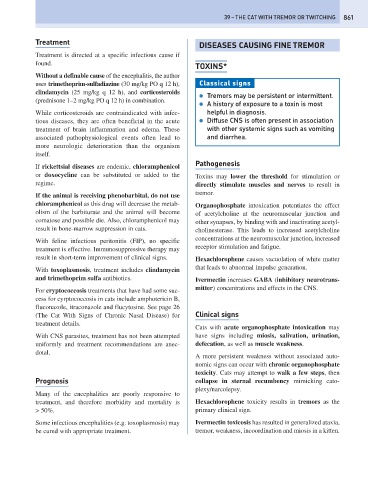Page 869 - Problem-Based Feline Medicine
P. 869
39 – THE CAT WITH TREMOR OR TWITCHING 861
Treatment
DISEASES CAUSING FINE TREMOR
Treatment is directed at a specific infectious cause if
found.
TOXINS*
Without a definable cause of the encephalitis, the author
uses trimethoprim-sulfadiazine (30 mg/kg PO q 12 h), Classical signs
clindamycin (25 mg/kg q 12 h), and corticosteroids
● Tremors may be persistent or intermittent.
(prednisone 1–2 mg/kg PO q 12 h) in combination.
● A history of exposure to a toxin is most
While corticosteroids are contraindicated with infec- helpful in diagnosis.
tious diseases, they are often beneficial in the acute ● Diffuse CNS is often present in association
treatment of brain inflammation and edema. These with other systemic signs such as vomiting
associated pathophysiological events often lead to and diarrhea.
more neurologic deterioration than the organism
itself.
Pathogenesis
If rickettsial diseases are endemic, chloramphenicol
or doxocycline can be substituted or added to the Toxins may lower the threshold for stimulation or
regime. directly stimulate muscles and nerves to result in
If the animal is receiving phenobarbital, do not use tremor.
chloramphenicol as this drug will decrease the metab- Organophosphate intoxication potentiates the effect
olism of the barbiturate and the animal will become of acetylcholine at the neuromuscular junction and
comatose and possible die. Also, chloramphenicol may other synapses, by binding with and inactivating acetyl-
result in bone-marrow suppression in cats. cholinesterase. This leads to increased acetylcholine
With feline infectious peritonitis (FIP), no specific concentrations at the neuromuscular junction, increased
treatment is effective. Immunosuppressive therapy may receptor stimulation and fatigue.
result in short-term improvement of clinical signs. Hexachlorophene causes vacuolation of white matter
With toxoplasmosis, treatment includes clindamycin that leads to abnormal impulse generation.
and trimethoprim sulfa antibiotics. Ivermectin increases GABA (inhibitory neurotrans-
For cryptococcosis treatments that have had some suc- mitter) concentrations and effects in the CNS.
cess for cyrptococcosis in cats include amphotericin B,
fluconazole, itraconazole and flucytosine. See page 26
(The Cat With Signs of Chronic Nasal Disease) for Clinical signs
treatment details.
Cats with acute organophosphate intoxication may
With CNS parasites, treatment has not been attempted have signs including miosis, salivation, urination,
uniformly and treatment recommendations are anec- defecation, as well as muscle weakness.
dotal.
A more persistent weakness without associated auto-
nomic signs can occur with chronic organophosphate
toxicity. Cats may attempt to walk a few steps, then
Prognosis collapse in sternal recumbency mimicking cato-
plexy/narcolepsy.
Many of the encephalities are poorly responsive to
treatment, and therefore morbidity and mortality is Hexachlorophene toxicity results in tremors as the
> 50%. primary clinical sign.
Some infectious encephalities (e.g. toxoplasmosis) may Ivermectin toxicosis has resulted in generalized ataxia,
be cured with appropriate treatment. tremor, weakness, incoordination and miosis in a kitten.

